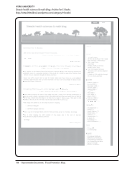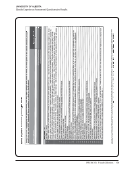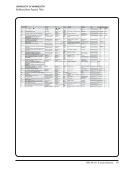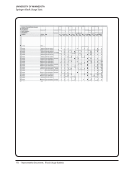14 · Survey Results: Executive Summary
interviews. Others comment that e-books tend to be
found regardless of library efforts.
The survey indicates there is considerable activity
in training library staff to use and promote e-books.
Sixty-six percent of those responding engage in activi-
ties to educate library workers. Much of this took the
form of in-house training sessions, either by librar-
ians or by vendors. Internal newsletters, discussions
at staff meetings, and brown bag lunches are other
methods used to raise staff awareness. One Head
of Acquisitions arranged for visits by each major e-
book publisher and vendor as an “e-book college”
for selectors.
For a look at specific selector concerns, see “Ebooks
Experience Assessment Questionnaire Results” con-
ducted by the University of Alberta Libraries on page
156 of the Representative Documents section. One
of the reasons listed for not selecting e-books is that
“the process of purchasing ebooks is not sufficiently
straightforward or convenient.”
E-Book Reader Devices
The survey asked what types of equipment can be
used to read the e-books in the library’s collections. A
wide range of responses was given, including desktop,
laptop, or tablet computers, PDAs, mobile phones,
and MP3 players. Only 10 libraries reported they are
lending mobile e-book readers, though. The North
Carolina State University library, for example, has a
well-established program with 12 Kindles and two
Sony Readers available for loan. Other libraries have
just a few devices available for loan, and some have
recently purchased a device that is not yet in circula-
tion pending policy and marketing plans. Most librar-
ies, however, do not offer device loans and are not
considering them.
When available, the devices often fall in with other
equipment loans at the library such as a laptop lend-
ing program. The devices are pre-loaded by the li-
brary, generally with popular titles. Some libraries
allow patrons to request a specific title the library
purchases the title, loads it on the reader, and makes
that particular device available to the patron.
See the Representative Documents section un-
der E-book Reader Loan Policies for links to device
policies and the Selected Resources section under
Additional Library E-book Sites to see what titles are
being loaded on the e-book devices.
Usage Tracking
Eighty-three percent of the responding libraries (60 of
72) reported tracking or monitoring usage of e-books
while 17% do neither. Most libraries rely on statistics
provided by the e-book vendor/publisher however
these statistics vary in quality. (See the Representative
Documents section for sample reports.) The frequently
collected data is the number of downloads, but other
controls include pages viewed, copied, and printed
number of successful searches and number of search-
es turned away. One respondent commented that the
e-book statistics “are a good indicator of use and allow
for very revealing comparisons to printed book us-
age.” However, the lack of consistent presentation by
vendors and publishers not using COUNTER statistics
makes for a work-intensive project.
Benefits and Challenges
One of the most interesting sections of the survey
contains the Benefits and Challenges responses shown
by individual respondent (see survey questions 29
and 30). Sixty-eight respondents commented on e-
book benefits. The responses are, for the most part,
listed one per box in simple phrases. By far, the most
listed benefit is anytime, anywhere access, sometimes
broken down into two parts: 24/7 access and remote
access. See Table 1 for a summary of the top benefits.
Sixty-seven respondents listed challenges. These
comments range from single words to whole para-
graphs, and the issues run the gamut from library
growing pains to serious vendor problems to industry
level issues. Taken together, they provide a snapshot
of hopes and disappointments with the developing
format. As indicated in Table 1, the challenges pres-
ent more complex and diverse issues compared to the
benefits but this should not be taken to indicate that
the challenges outweigh the benefits.
At the library level, the main challenges are per-
sonnel and the changing workflow. One library rather
tactfully lists not having internal consensus on e-
books as a challenge. Other responses show more
frustration in naming librarian resistance as a real
problem in moving forward. Evolving workflow is
interviews. Others comment that e-books tend to be
found regardless of library efforts.
The survey indicates there is considerable activity
in training library staff to use and promote e-books.
Sixty-six percent of those responding engage in activi-
ties to educate library workers. Much of this took the
form of in-house training sessions, either by librar-
ians or by vendors. Internal newsletters, discussions
at staff meetings, and brown bag lunches are other
methods used to raise staff awareness. One Head
of Acquisitions arranged for visits by each major e-
book publisher and vendor as an “e-book college”
for selectors.
For a look at specific selector concerns, see “Ebooks
Experience Assessment Questionnaire Results” con-
ducted by the University of Alberta Libraries on page
156 of the Representative Documents section. One
of the reasons listed for not selecting e-books is that
“the process of purchasing ebooks is not sufficiently
straightforward or convenient.”
E-Book Reader Devices
The survey asked what types of equipment can be
used to read the e-books in the library’s collections. A
wide range of responses was given, including desktop,
laptop, or tablet computers, PDAs, mobile phones,
and MP3 players. Only 10 libraries reported they are
lending mobile e-book readers, though. The North
Carolina State University library, for example, has a
well-established program with 12 Kindles and two
Sony Readers available for loan. Other libraries have
just a few devices available for loan, and some have
recently purchased a device that is not yet in circula-
tion pending policy and marketing plans. Most librar-
ies, however, do not offer device loans and are not
considering them.
When available, the devices often fall in with other
equipment loans at the library such as a laptop lend-
ing program. The devices are pre-loaded by the li-
brary, generally with popular titles. Some libraries
allow patrons to request a specific title the library
purchases the title, loads it on the reader, and makes
that particular device available to the patron.
See the Representative Documents section un-
der E-book Reader Loan Policies for links to device
policies and the Selected Resources section under
Additional Library E-book Sites to see what titles are
being loaded on the e-book devices.
Usage Tracking
Eighty-three percent of the responding libraries (60 of
72) reported tracking or monitoring usage of e-books
while 17% do neither. Most libraries rely on statistics
provided by the e-book vendor/publisher however
these statistics vary in quality. (See the Representative
Documents section for sample reports.) The frequently
collected data is the number of downloads, but other
controls include pages viewed, copied, and printed
number of successful searches and number of search-
es turned away. One respondent commented that the
e-book statistics “are a good indicator of use and allow
for very revealing comparisons to printed book us-
age.” However, the lack of consistent presentation by
vendors and publishers not using COUNTER statistics
makes for a work-intensive project.
Benefits and Challenges
One of the most interesting sections of the survey
contains the Benefits and Challenges responses shown
by individual respondent (see survey questions 29
and 30). Sixty-eight respondents commented on e-
book benefits. The responses are, for the most part,
listed one per box in simple phrases. By far, the most
listed benefit is anytime, anywhere access, sometimes
broken down into two parts: 24/7 access and remote
access. See Table 1 for a summary of the top benefits.
Sixty-seven respondents listed challenges. These
comments range from single words to whole para-
graphs, and the issues run the gamut from library
growing pains to serious vendor problems to industry
level issues. Taken together, they provide a snapshot
of hopes and disappointments with the developing
format. As indicated in Table 1, the challenges pres-
ent more complex and diverse issues compared to the
benefits but this should not be taken to indicate that
the challenges outweigh the benefits.
At the library level, the main challenges are per-
sonnel and the changing workflow. One library rather
tactfully lists not having internal consensus on e-
books as a challenge. Other responses show more
frustration in naming librarian resistance as a real
problem in moving forward. Evolving workflow is
























































































































































































